Cryptocurrency is a relatively independent emerging technology, which makes its path to mass adoption unique challenges. While blockchain projects promise to disrupt various established technology businesses, this requires building a thriving community of active users who have shifted their activities from established tracks to the cryptocurrency space. The problem is that this is one of the most difficult challenges for blockchain projects because established technologies work well for the most part. What's more, there are thousands of blockchain projects that are often similar to each other and compete for the same attention and users. The vast majority of these projects are essentially "a technology idea trying to build a community from scratch."
Telegram, as the leading cryptocurrency messaging platform, is on the road to 1 billion active users. Telegram's versatility, security, and speed make it the platform of choice for cryptocurrency users. It enables seamless communication between individuals and teams. For the industry, Telegram has played an important role in large-scale community building, providing projects with tools to interact with their audiences, spread information, and cultivate a sense of belonging. It may be one of the best tools for cryptocurrency projects to build communities.
Telegram’s large user base and free, open API provide an unparalleled opportunity for cryptocurrency projects to integrate their products into an existing vibrant community with a very large cryptocurrency user base. Recognizing this potential, TON stands out as the best strategic fit with Telegram. But there are also signs that other blockchain ecosystems will be further integrated into Telegram.
Telegram’s High-speed Development
TON has recently attracted a lot of attention and performed well across the cryptocurrency market since it was announced as Telegram’s “official Web3 infrastructure” at the TOKEN2049 Singapore event in September 2023. At the event, Telegram and the TON Foundation jointly announced TON Space, a new self-custodial wallet that integrates directly into the official Telegram wallet and includes the Telegram wallet in the settings and attachments menu for all non-US users.
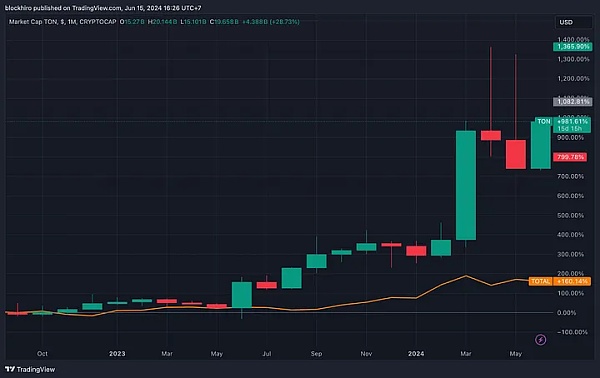
TON Space is a game-changer. While some may think this is just Telegram adding a self-hosted wallet, the broader view is that Telegram has effectively become a self-hosted wallet with nearly 1 billion users, seamlessly connecting users to numerous in-platform crypto applications and allowing users to communicate privately or in groups within the platform without leaving the platform. No other wallet offers this user experience. Most wallets lack direct app integration or social features beyond simple transactions, and require users to go through a cumbersome login process between different browser-based applications, severely limiting usability. Telegram's all-in-one experience is critical to mass adoption. Imagine if Instagram or X required you to log into a separate browser application to send a message or comment on a friend's post, or if you had to use a different browser application to attach a file from your cloud storage to an email.
The renewed collaboration between Telegram and TON has caught the attention of prominent VCs, with Pantera Capital making its largest investment ever in TON, and other firms expressing recent interest. Unlike most blockchain projects that struggle to build new communities, TON’s deep integration with Telegram positions it as “a community that integrates blockchain.” As Pantera noted in their investor letter, “it’s bound to be easier.”
TON: The Spotify of Crypto
TON’s recent embed in Telegram reminds me of Spotify’s partnership and integration with Facebook in 2011, which was a significant moment for the music streaming industry. Spotify’s integration with Facebook enabled users to share their listening habits and playlists directly on the giant social media platform, greatly boosting Spotify’s visibility and usage. In just four days, Spotify gained 1 million new Facebook-connected users. And in six weeks, Spotify users connected to Facebook shared more than 1.5 billion listening sessions through Facebook’s Open Graph, which allows developers to integrate their apps into the social media platform. From then on, the rest is history.
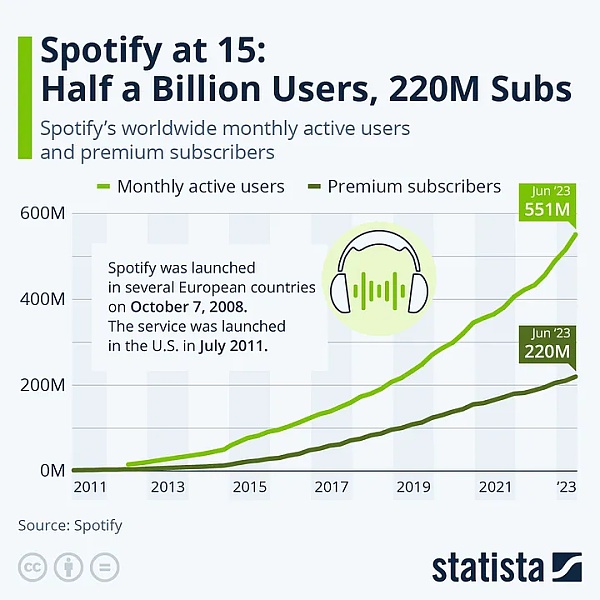
Similarly, TON’s integration with Telegram enables TON developers to integrate their apps into Telegram’s massive social network, making it easier for users to discover and use TON’s apps and services. Just as Spotify leveraged Facebook’s social graph to build a community around music sharing, TON leverages Telegram to build a community around value transfer.
TON has maintained steady growth since Telegram endorsed it. Recently, the total value locked (TVL) in TON smart contracts exceeded $1 billion, an increase of two orders of magnitude from before the event.
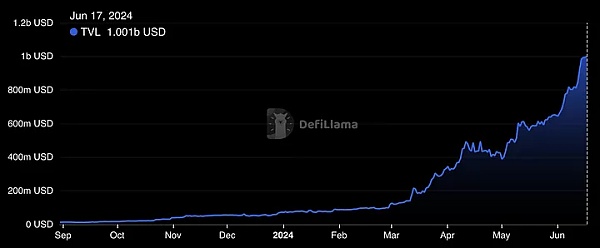
TON’s daily active wallets continue to hit record highs.
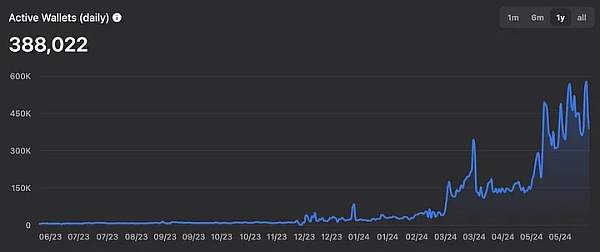
TON’s token holders and transaction volumes show a strong upward trend.

While there are limitations to reasoning by analogy, there are compelling similarities between Facebook and Spotify, and Telegram and TON. In Q3 2011, when Facebook integrated Spotify into the platform, Facebook had approximately 800 million users, while Spotify had 2 million paid subscribers. Less than a year later, Spotify had grown to over 4 million paid subscribers. Similarly, when Telegram integrated TON in Q3 2023, Telegram also had approximately 800 million users, while TON had approximately 100,000 monthly active wallets. Less than a year later, TON had grown to approximately 5.5 million monthly active wallets.
While TON’s growth in active users is an order of magnitude of Spotify’s growth, it is important to note that a direct comparison of Spotify’s subscribers from a decade ago to active TON wallets today is inaccurate. Importantly, adoption of new technologies grows significantly when integrated into a large social network.
Given that TON has only touched a small portion of Telegram’s user base to date, it is reasonable to expect that its growth will continue as the technology improves and use cases expand.
Beyond TON: Cryptocurrency on Telegram
Although Telegram has officially endorsed and given TON some exclusive benefits on the platform, they will most likely remain an independent organization due to legal issues. This is good for other blockchain projects, as Telegram keeps its API free and open for developers to use, which promotes healthy competition and innovation.
When discussing TON and Telegram, it is important not to ignore other ecosystems integrating into Telegram. In particular, NEAR is probably the second most integrated chain with Telegram, quietly making moves to establish a strong presence on Telegram.
The most notable examples are NEAR’s self-hosted HERE wallet and its lightweight Telegram implementation, HOT wallet, which launched in early February. With a focus on user engagement and simplifying the process of plugging into the NEAR ecosystem through Telegram, the HOT wallet serves as NEAR’s answer to the Telegram TON wallet.
Creating a new NEAR account with HOT Wallet is as easy as opening the Telegram app and tapping the screen a few times to generate a readable NEAR address that is automatically assigned to your Telegram username (e.g., blockhiro.tg).
To increase user engagement, HOT Wallet adopted the gamification strategy of the popular Notcoin app on TON, which launched a month ago and attracted millions of users in its first week. Similar to Notcoin, HOT Wallet users can mine its native token directly on the app through a fun game that combines social features, tasks, and upgrades.
Within 10 days of launch, more than one million Telegram users created NEAR accounts on HOT Wallet. Since its launch, it has been ranked number one on DappRadar multiple times.

In Q1, HOT wallet had an average of about 370,000 daily users, accounting for nearly 30% of NEAR's daily active addresses. So far in Q2, the average daily active users have increased to about 500,000.
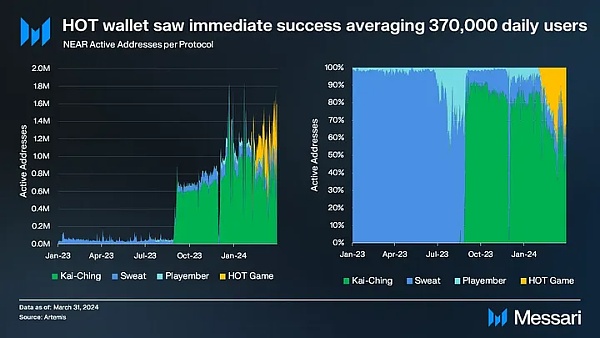
NEAR's success with Telegram raises the question: Will TON continue to be Telegram's *only* Web3 infrastructure, or will it become *one* of the Web3 infrastructures? While TON has been receiving attention, NEAR and other potential blockchain projects should not be ignored. In the coming months and years, I will be keeping a close eye on the developments in other blockchain ecosystems.
tApps (Crypto Apps on Telegram)
The recent improvements in user experience among crypto apps on Telegram (called “tApps”)—from drab proxy page-style trading bots to full apps—paved the way for the rise of more high-engagement mining games and other tApps. Notcoin and HOT Wallet are just the beginning. There are now many popular “mining+” tApps on multiple chains that have attracted millions of players by providing simple and fun ways to play and earn. Here are some examples:
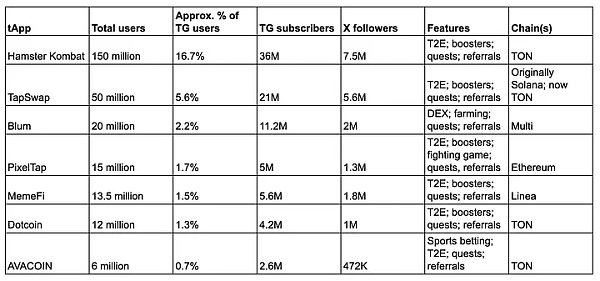
The user growth of these seemingly simple apps is extraordinary! For example, Hamster Kombat reached 100 million users in less than three months, placing it between ChatGPT and TikTok in terms of user acquisition speed. Simple estimates suggest that at least 10% of Telegram users tried the game a few months after the app launched, demonstrating Telegram’s strong reach in Web3 user acquisition (user retention is another story).
As the tApp category grows, there are signs that they are moving toward multi-chain (e.g. MemeFi, Blum) and becoming more than just Notcoin copycats (e.g. AVACOIN, PixelTap). Some people associate this category with memecoins, given the memetic nature of Notcoin that started it all, but I beg to differ. In some ways, current tApps and memecoins are similar in their emphasis on convenience and fun — a stark departure from the serious technical jargon we often see in crypto. But unlike memecoins, tApps offer full functionality like games and tasks, attracting real usage from the potentially hundreds of millions of crypto-ready users already on Telegram or willing to join Telegram.
Apps that integrate with cryptocurrencies on Telegram have started small, but now is the time for them to grow into more sophisticated platforms that rival other mobile apps. New tApps can combine and fuse gaming, social, and other engagement mechanisms to provide a richer user experience for cryptocurrency users and newcomers.
tApps spanning multiple blockchain ecosystems beyond TON will further solidify Telegram’s position in the broader crypto industry and strengthen existing connections between various crypto communities and Telegram. If these applications can not only leverage Telegram’s existing user base but also attract new users and developers, this may incentivize Telegram to provide more support for more chains. This could be achieved by providing broader API access, higher server-side rate limits, or extended availability in settings and menus.
Conclusion
To achieve mass adoption, we should look beyond TON or any specific blockchain protocol and consider Telegram in the broader context of the digital asset space, information security, and globalization. Telegram has become a global communications giant with extensive penetration in North America, Latin America, Asia, and Europe. Its massive user base, combined with innovative features at the forefront of information security and technology adoption, makes Telegram the best platform for us to bridge the crypto island to the mainland. Just as Facebook spawned the rise of Spotify and music streaming in the 2010s, Telegram is the right product to accelerate blockchain adoption and drive the normalization of on-chain value transfer in the 2020s.
When discussing barriers to crypto mass adoption, the most common argument I hear is user experience (UX). Many believe that the main reason holding back crypto mass adoption is poor UX. However, I no longer believe this is the case. The rapid growth of accounts and activity on Telegram Wallet, Here Wallet, and tApps like Notcoin and Hamster Kombat shows that crypto UX is essentially ready for mainstream use. If it weren't, these apps wouldn't have grown to millions of users in a matter of days. I believe the real bottleneck is the lack of integration between isolated blockchain projects and larger social networks. Imagine what kind of activity would happen if these games were launched as standalone apps outside of Telegram.
Just as streaming technology revolutionized the way we consume audio and visual content by making it more accessible and convenient than ever before, blockchain projects should aim to achieve the same effect for value transfer. This won’t happen in silos. It will happen on platforms like Telegram, where blockchain applications can make value transfer between individuals, groups, and applications more accessible and convenient than anywhere else.
 JinseFinance
JinseFinance













